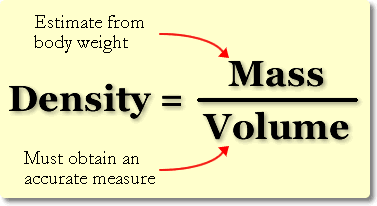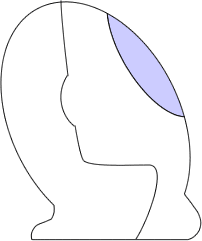Click a button to explore densitometry
Densitometry Theory
|
Densitometry: Estimating body composition from body density. Percent body fat can be calculated from body density. This section begins with a discussion of densitometry. It
then follows with an overview of the BodPod. |
|
| Density is defined as mass divided by volume. Body mass can be estimated from body weight, as measured by a high precision scale. Body volume must then be accurately measured to provide an accurate body density value. |
 |
| The
density of a material is a function of the density of its components.
For example, the human body can be divided into two compartments: fat
and fat-free. Each of the two compartments has its own density,
with fat-free tissue being more dense than fat tissue. |
||
|
Models and formulas have been derived that make it possible to calculated %fat from body density. |
As shown in the image on the right, a more complex compartment model of the body can be constructed, since fat-free mass is actually made up of several types of materials. Increased measurement accuracy may be obtained by combining the densitometry technique with other body composition measurement methods. These other methods measure some of the other compartments shown (e.g. mineral by DXA, protein by prompt gamma, water by BIA). |
Fat-free mass can be further subdivided into other compartments. |
|
Measurement of %fat by densitometry relies on certain assumptions:
In actuality, there are certain factors that can affect fat-free mass composition and density. These include growth and maturation, physical training, aging, race, and sex. Some or all of these factors need to be taken into account when using densitometry for body composition assessment. How does the BodPod measure body volume?
|
||
|
The BodPod uses a technique called Air Displacement Plethysmography (ADP). This technique relies on the physics of Boyle's Law, which states that pressure and volume vary inversely with one another. In other words, as pressure goes up, volume goes down, and vice versa. Monitoring pressure changes in a closed chamber allows one to calculate volume. The
volume of the empty measurement chamber (see schematic)
is determined first. The test is then performed with the subject inside,
and that volume is measured. In the second measurement, the chamber
volume has been reduced by an amount equal to the subject's volume.
So by subtraction, the volume of the subject can be calculated. |
 |
|
The
BodPod uses a diaphragm to cause small volume changes in a chamber
and then measures pressure responses.
|
|
To obtain an accurate volume measurement using ADP, lung volume must be taken into account. The BodPod performs a separate test and measures the average lung volume, because the subject is breathing normally during the initial body volume test. (Other densitometry techniques require the subject to empty their lungs during a test.)
USDA/ARS
Children's Nutrition Research Center
|